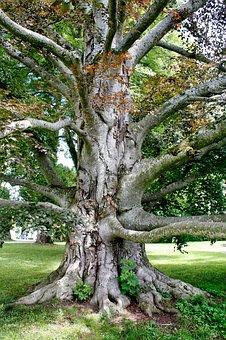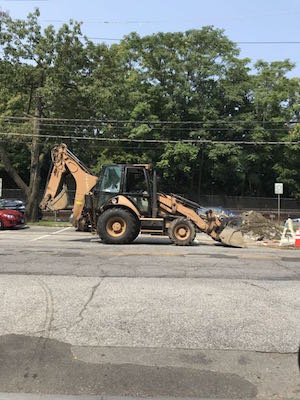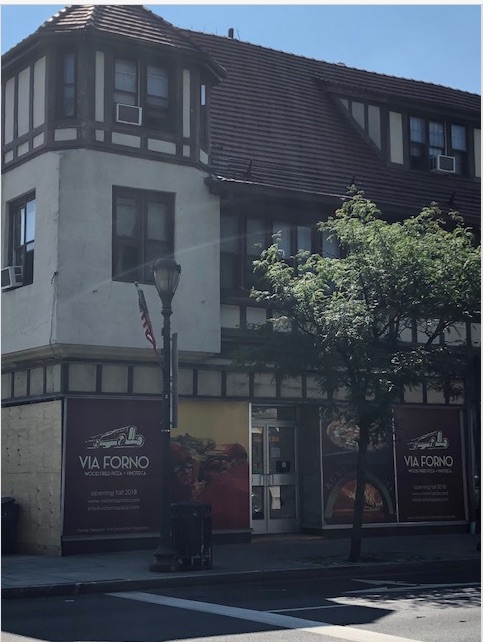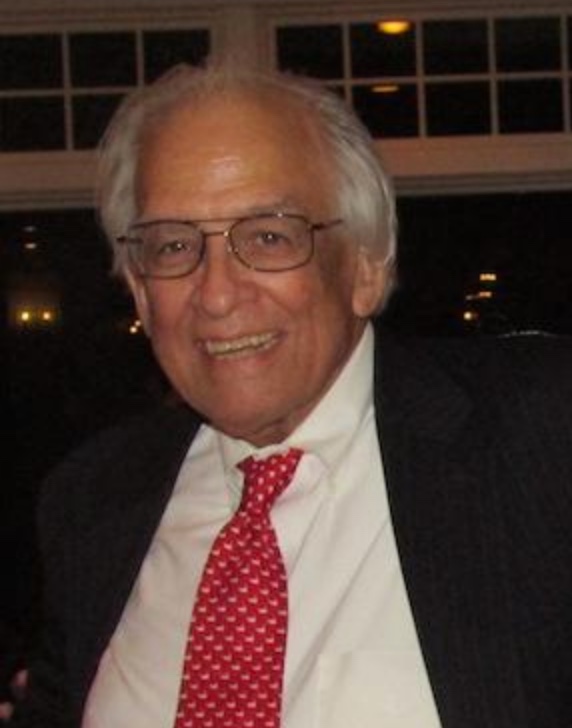Trustees Ask for More Revisions to Proposed Clear-Cutting Code
- Details
- Written by: Joanne Wallenstein
- Hits: 3275
 Scarsdale Trustees considered, but failed to agree on new provisions to prevent the clear cutting of trees on Scarsdale properties at their meeting on September 12. Members of the Conservation Advisory Council recommended new rules governing tree removal, but after considerable discussion, Law Committee Chair Carl Finger asked Village staff to make several changes and clarifications to the recommended code and schedule another committee meeting to review it.
Scarsdale Trustees considered, but failed to agree on new provisions to prevent the clear cutting of trees on Scarsdale properties at their meeting on September 12. Members of the Conservation Advisory Council recommended new rules governing tree removal, but after considerable discussion, Law Committee Chair Carl Finger asked Village staff to make several changes and clarifications to the recommended code and schedule another committee meeting to review it.
Last spring, Trustees passed some new tree provisions but stopped short of passing new laws involving the removal – or clear cutting – of clusters of trees. At their meeting on April 24, 2018, Trustees passed the following laws regarding tree removal:
Replacement Trees: A replacement tree is required for a removed tree that is 24'' diameter (reduced from 36'' diameter). Replacement trees need to be 3'' in diameter and a native species.
As of Right Removal: Homeowners can continue to remove 2 trees as of right per year (under 24'' diameter).
Dead, Dying, Hazardous or Diseases Trees: Trees in any of these conditions (of any size) can be removed without the need for a replacement tree
Tree Permits: A permit is required to remove six small caliper trees above 3'' in diameter. Permits for all other trees remain at 6'' diameter. Trees, aside from the six small caliper ones listed in the code, do not require a permit to remove if under 6'' diameter.
Protected Trees: They updated the list of protected trees to align with endangered native trees.
On Wednesday September 12, 2018 the trustees discussed an "aggregate test" provision to the tree code which look at the Total DBH (diameter at breast height) of any tree that requires a permit (for example 2'' trees are not included in the total of DBH since they wouldn't require a permit to remove) to determine the number of replacement trees required.
Specifically, they agreed that they favored Option A which reads as follows:
Permitted trees removed having an aggregate DBH of 48 inches or greater:
• A 2 inch DBH replacement tree of a genus and species expected to grow to a maturity at a similar size to the removed tree or trees shall be planted for every 24 inches of DBH removed up to 120 inches of aggregate DBH;
• Two 2 inch DBH replacement tree of a genus and species expected to grow to a maturity at a similar size to the removed tree or trees shall be planted for every 24 inches of DBH removed above 120 inches and less than 240.1 inches aggregate DBH and if payment to the Tree Preservation Fund in lieu of replacement tree is utilized, then the payment shall be double the amount set by the Village Board in its annual fees and charges schedule;
• No trees shall be removed above 240 inches aggregate DBH.
Opening the discussion Trustee Carl Finger who heads the Law Committee explaned the intent of the new code, saying, “This is targeted to the 6-10% of most significant tree removers … the people who remove the most trees will be affected the most.”
In the discussion at the meeting, Trustee Lena Crandall said, “We need our trees…. this is an incremental step.” Matt Callaghan said, “this is a good start though it my need to be tweaked again.” Mayor Dan Hochvert explained that he replaced a diseased 40 inch oak with a new two inch oak that he hopes will be on the property for several generations. Trustee Ross said, “Having this codified leads to greater predictability.”
However Trustees Justin Arest and Jane Veron were not on board. Arest said, “ I hoped we could do this through the land use process. Should we focus on the higher end at the beginning?”
Veron said, “I don’t believe that this legislation gets at our goal. Our goal gets at replacement. I prefer attacking this through the land use process. Applications come through the boards. At the land use board we can ask whether we can we change the footprint of the house and save the trees? I don’t think this will solve the problem. It will raise funds to plant trees.”
She continued, “I am a gradual change person. We just changed legislation and we don’t know the consequences. I would rather proceed more modestly.”
Carl Finger responded, saying, “I don’t understand why the discussion you’re talking about can’t still happen – even with this law?” He commented later, “I sat on the BAR and was in the room for those discussions. Jane was on the Planning Board they had more leverage to negotiate. It’s hard to have a one size fits all solution. The greater impact will be on the big lots. It is not simply that you can pay instead of planting replacement trees.”
Mayor Hochvert said, “The Board of Architectural Review says they don’t have the uumph that they would have if we passed this code. The BAR is having difficulty.”
In comments from the public, Claudine Gecel of Kent Road spoke passionately about tree removal. Arguing for the regulations she told the trustees, “You go to the BAR meeting and you duke it out there.”
Bob Berg objected to the new code calling it a “hyrda” that keeps on expanding. He said, “It is more complicated than the IRS code – no one can get through it. This is based on a back of the napkin analysis. This is not the basis to enact a new law. You enacted a new law in April over considerable opposition. Address clear cutting through a land use board. The developers don’t care how much they have to pay to replace the trees. It’s pocket change to them. It offends people on smaller properties ho want to remove 5 or 6 trees.”
Trustee Justin Arest responded to Berg, saying “I thought you were upset about a property owner who removed a lot of trees a few months ago – and we couldn’t prevent it because we had no clear cutting code.” To which Berg said, “I am sure this wouldn’t address that!”
Ron Schulhof said, “I worked on this as part of the CAC. My personal view is that many changes to land use laws need to be made. This does not preclude that. You need underlying code – in addition to the negotiations at the land use boards. Dead, diseased dying trees are not included. You can’t take every tree and put it into the tree preservation fund. If a developer wants to take down 40 trees, many will need to get replaced. If you were to use the tree preservation fund – what is that amount?
Maybe I can save this tree so I don’t pay? Penalties for illegal tree removal should be adjusted so they are higher than the tree removal fees. I would do 3 inch replacements – rather than 2 inch replacements. Current code was 3 inches. In terms of timing, I think it should be longer than a 12 month period.”
As the meeting concluded, Finger asked Village staff to revise the proposed code and consider the aggregate number of 48 inches, saying we might need different aggregates for each zone. He asked them to look at the time span for the tree removal regulations, to outline the penalties and to make a recommendation about the size of the replacement trees – either 2” or 3” DBH.
Trustees to Consider New Provisions on Tree Removal and Clear Cutting
- Details
- Written by: Joanne Wallenstein
- Hits: 3642
 The Law and Sustainability Committees of the Scarsdale Board of Trustees will meet on September 12, 2018 at 6 pm at Scarsdale Village Hall to consider additional changes to the laws governing the removal of trees.
The Law and Sustainability Committees of the Scarsdale Board of Trustees will meet on September 12, 2018 at 6 pm at Scarsdale Village Hall to consider additional changes to the laws governing the removal of trees.
Last spring, Trustees passed some new tree provisions but stopped short of passing new laws involving the removal – or clear cutting – of clusters of trees.
At their meeting on April 24, 2018, Trustees passed the following laws regarding tree removal:
Replacement Trees: A replacement tree is required for a removed tree that is 24'' diameter (reduced from 36'' diameter). Replacement trees need to be 3'' in diameter and a native species.
As of Right Removal: Homeowners can continue to remove 2 trees as of right per year (under 24'' diameter).
Dead, Dying, Hazardous or Diseases Trees: Trees in any of these conditions (of any size) can be removed without the need for a replacement tree
Tree Permits: Addition of six small caliper trees that require a permit above 3'' in diameter. Permits for all other trees remain at 6'' diameter. Trees, aside from the six small caliper ones listed in the code, do not require a permit to remove if under 6'' diameter.
Protected Trees: They updated the list of protected trees to align with endangered native trees.
On Wednesday September 12, 2018 the trustees will discuss an "aggregate test" provision to the tree code which would aim to address clear cutting. The aggregate test would look at the Total DBH (diameter at breast height) of any tree that requires a permit (for example 2'' trees are not included in the total of DBH since they wouldn't require a permit to remove) to determine the number of replacement trees required. This was originally proposed by the Tree Working Group but the Board of Trustees decided to discuss this proposal separately from the other tree code changes.
Please click here to review proposed changes to the tree code that will be discussed at the September 12th meeting:
Post Road to be Repaved, New Gas Main on Scarsdale Avenue
- Details
- Written by: Joanne Wallenstein
- Hits: 3819
 (The following announcements are from Scarsdale Village Managers)
(The following announcements are from Scarsdale Village Managers)
The New York State Department of Transportation is scheduled to repave the portion of Post Road passing through Scarsdale in its entirety starting on Monday, August 6th. This estimated $2.1M project is not your everyday asphalt resurfacing.
The NYSDOT is going to do the job right so that it addresses a variety of existing physical roadway problems and ultimately delivers a traveling surface that will withstand the test of time and heavy usage. Doing it right translates into noise, lights, and heavy vehicle construction work involving long sections of Post Road. The Village is working with NYSDOT officials to minimize adverse impacts, but they are largely unavoidable given the project scope and location.
Heavy machinery and portable roadway construction lighting will be deployed between the hours of 7:00 p.m. and 6:00 a.m., Sunday through Thursday, beginning on Monday, August 6th. NYSDOT will endeavor to conduct the most disruptive elements of their work as early as possible on each day so as to minimize nighttime noise.
The work will begin near the border with Eastchester and proceed north from there, with the completion estimated for shortly after Labor Day. Residents and other Post Road users should avoid travel on Post Road as much as possible, as there will be lane closures and heavy construction activity. Motorists are advised to follow any posted detours and adhere to construction zone speed limits.
Official NYSDOT Traffic Alerts are available using 511 and through the NYSDOT website.
Con Edison to Replace Scarsdale Avenue Gas Main
Beginning on Wednesday, August 15th, Con Ed is beginning an estimated three to four week project involving replacing and upgrading the aging underground gas main on Scarsdale Avenue between Popham Road and Wright Place. Monday,
August 20th, through Friday, September 14th (estimated).
Major roadway excavation and gas main replacement between 8:00 PM to 6:00 AM.
Phase II is being performed at night to minimize otherwise potentially significant traffic and business impacts.
During construction hours, Scarsdale Avenue will be reduced to one lane, managed by Scarsdale PD to provide for travel in both directions on an alternating basis.
Expect construction lighting at night, roadway excavation noise, traffic management measures, and Scarsdale Avenue parking restrictions – watch for postage signage.
Motorists are encouraged to observe and obey all traffic and parking-related restrictions in the construction zone, and to exercise caution while traveling along Popham Road, particularly in the area of the intersection with Scarsdale Avenue.
New Restaurants Opening and Infrastructure Improvements in Process: News from the Village Board
- Details
- Written by: Laura Halligan
- Hits: 15786
 Despite the dog days of summer, Scarsdale continues to move ahead, as reported at this week’s board of trustees meeting.
Despite the dog days of summer, Scarsdale continues to move ahead, as reported at this week’s board of trustees meeting.
In his remarks, Scarsdale Village Manager Steve Pappalardo reminded residents about paving work on Post Road and the replacement of a gas main on Scarsdale Avenue.
The New York State Department of Transportation has begun prep work for resurfacing the roadway; moving north from Eastchester, contractors are replacing/installing handicap access ramps, adjusting manholes and removing asphalt prior to pouring new asphalt. To minimize negative effects for motorists and residents, is being done between 7:00 pm and 6:00 am, Sunday through Thursday, with the most disruptive activities planned for early in the evening each day to reduce nighttime noise. The project should be completed in early September.
In downtown Scarsdale, Con Ed has started replacing and upgrading an old underground gas main on Scarsdale Avenue, between Popham Road and Wright Place. The three- to four-week project will be completed in two phases – daytime work is scheduled between August 15 and 18, and nighttime work is planned from August 30 through September 14. While minimal disruption is expected during the first phase of work, residents are advised to expect more significant traffic and parking restrictions, as well as excavation noise during the second phase of the project.
In both cases, some short-term pain certainly will lead to long-term gain. A gas main on Scarsdale Avenue is being replaced by Con Edison.
A gas main on Scarsdale Avenue is being replaced by Con Edison.
Perhaps more exciting news came from Trustee Jane Veron, who discussed two new restaurants that will be coming to Scarsdale.
Via Forno Wood Fired Pizza & Vinoteca will open in the former 7-Eleven space on Garth Road this coming fall. The restaurant, described as “a modern interpretation of traditional wood-fired pizza restaurant and wine bar concept,” will feature an outdoor dining area at the corner of Garth and Popham Roads.
Veron also announced that the White Plains eatery Sapori is expanding to a second location in Scarsdale. The highly regarded Italian restaurant will move into the space that most recently was occupied by Wuji, on Chase Road.
In addition, she discussed her work with the new Scarsdale Business Alliance, which recently hosted the village’s annual sidewalk sale and has begun planning for the next “Light the ‘Dale” event, among other activities. And, in related news, the Scarsdale Farmers’ Market will close at the end of August, and review resident feedback and comments in preparing to re-launch in the fall.
Veron concluded her comments with an update on the work of the Scarsdale Ad Hoc Communications Committee, which has been developing a volunteer portal for scarsdale.com and creating new resident information materials throughout the summer.
Mayor’s Comments
Mayor Dan Hochvert provided a recap of his activities during the past weeks, which included making progress on a number of initiatives of interest to residents.
First, in an effort to learn more about distributed antenna systems (DAS) that are being proposed for Scarsdale, Hochvert and Trustee Justin Arest spoke with Rye City Mayor Joshua Cohn about Crown Castle’s second lawsuit against Rye over a stalled proposal to place DAS in the municipality. Late last year, a federal judge dismissed a lawsuit filed by the company against Rye, which accused the city of violating federal law when it required Crown Castle to conduct additional reviews of its proposal. Cohn will continue to provide Scarsdale officials with updates as the situation develops.
Also, Hochvert and other municipal officials met with Westchester County Executive George Latimer to talk about “bridge strikes,” or trucks hitting bridges on local roadways, which inevitably lead to traffic nightmares. An increasing number of truck drivers, following their GPS systems, enter local parkways, such as the Hutchinson River Parkway, and crash into low bridges that they cannot clear. In the first half of 2018, there were dozens of bridge strikes in Westchester. Latimer is interested in working with Scarsdale, Rye Brook and Rye to roll out new methods to alert drivers.
More recently, in advancing Scarsdale’s sustainability efforts, Hochvert met with county officials to review ideas on reducing the number of plastic bags used throughout Westchester. While New York legislators didn’t act on proposals to impose a fee on plastic bags during their last session, a growing number of communities throughout the state are banning the use of single-use plastic bags by retailers and are promoting the use of reusable bags to reduce environmental waste.
In addition, Hochvert continues to encourage better communications with Con Ed and improve communications with the utility during emergencies and power outages. He and other Scarsdale officials met with local Con Ed representatives to outline ways to more effectively coordinate activities among Scarsdale Public Works Department, Scarsdale Police and Con Ed officials, and reported that the work will continue.
Public Comment
Zoe Berg (Tisdale Road) expressed her concerns about what she sees as a lack of “organized efforts to solicit input about what matters most to us here in Scarsdale.” She said, “Village board meetings… do not create an inclusive atmosphere that encourages dialogue… time limits, not responding to questions until the end of the speaking period, and refusing to engage in back and forth fosters apathy among our community… Why have no surveys been distributed to gain a better sense of residents’ needs? Why have no focus groups been created? What about a town hall? You are here for us, so please make an effort to engage with us and find out what we need to prioritize as village.”
Bob Berg (Tisdale Road) discussed Scarsdale’s property assessment processes and recommended a recent report prepared by the Scarsdale Forum Assessment Revaluation Committee. “…the forum’s (committee) published what I consider a brilliant, objective and highly informative study on how to do a proper town-wide property assessment… which is absolutely essential reading... The report uses examples of both the Tyler and Ryan revaluations to point out flaws and shortcomings that must be avoided in any future revals in Scarsdale, and it points out positive aspect, largely from the Tyler reval, that should be repeated.” He continued, “The real estate market in Scarsdale is rapidly changing… I expect prices to decline next year as buyers run the numbers and figure out the true after-tax cost of owning in Scarsdale, now that the federal income tax subsidy has been mostly removed. We’re going to need to do another reval within the next two to three years… given that reality… we’ve got to start the process soon.”
Bob Harrison (Fox Meadow Road) began his comments by announcing that the Scarsdale Youth Tennis League just completed its 34th season. This year, 45 children participated in over 335 matches. He then changed gears and asked the trustees about how many property tax grievances were filed this past June (approximately 550, a decrease from about 750 filed last year).
Matthew Miller (Roosevelt Place) concluded the public comment portion by mentioning his concerns about general discourse during board meetings. “When I hear… the mayor cutting me off when I (am) speaking… I (don’t) really care about that… On May 22, you told Bob Harrison, before he even spoke, to keep it to five minutes and, while he was speaking, you kept interrupting him… On June 26… he said it’s a little cold in here… and you guys said you have to keep the air conditioning going because we’re blowing hot air at you… That’s not right. I think it was terribly rude… I believe this community is a great community. I will keep coming here… trying to make this town great; I also think all you guys are wonderful people… we(just) can’t do those type of things.”
Former Village Justice John Galloway Passes Away
- Details
- Written by: Joanne Wallenstein
- Hits: 5247
 John H. Galloway III, affectionately known in Scarsdale as “the Judge,” passed away on August 3, 2018. Born on August 29, 1939 in New York, New York to Mary Phillips Galloway and John Henry Galloway Jr., John resided in the Scarsdale area for much of his life.
John H. Galloway III, affectionately known in Scarsdale as “the Judge,” passed away on August 3, 2018. Born on August 29, 1939 in New York, New York to Mary Phillips Galloway and John Henry Galloway Jr., John resided in the Scarsdale area for much of his life.
John attended Stepinac High School, Georgetown and Cornell Universities and Fordham Law School. John and his wife, Frances, formed a law practice in Scarsdale where they were partners in life and law for over 50 years. His compassion, dedication to fairness and kindness showed through in every aspect of his life. As Scarsdale Village Justice of 20 years, longtime Rotarian, active parishioner and educator at Immaculate Heart of Mary Church in Scarsdale, John lead a life that made a difference in others’ lives. He took great pleasure in Community Theater, sailing, bird watching, music and stargazing. The Galloways are long-time members of the Fox Meadow Tennis Club. Above all else, was his love for his family. He is survived by his wife, Frances Cassebaum Galloway, daughters Emily McGovern-Voliva and Sarah C. Galloway, brother, David Galloway, grandchildren Colleen McGovern, Erin McGovern and Kelly Ann McGovern. John was known by many and loved by all.
Commenting on the loss, Scarsdale Village Justice Jack Alemany said, “John Galloway was a great judge and a better person. The Village of Scarsdale and the legal community of Westchester County will miss him.
Scarsdale Village Manager Steve Pappalardo said, "John Galloway was a rare individual, smart, principaled, and respectful of all, a more empathetic, human being you won't find. Every defendant had their day in court when Judge Galloway precided and his decisions were fair and balanced. I will miss him for his friendship and kindness."
Mass of Christian Burial Tuesday August 7, 2018 at Immaculate Heart of Mary Church Scarsdale 10AM. A memorial luncheon will be held immediately following the mass at the Scarsdale Congregational Church 1 Heathcote Road Scarsdale NY 10583.
In lieu of flowers please make any contribution to Calvary Hospital, 1740 Eastchester Road, Bronx, New York.










